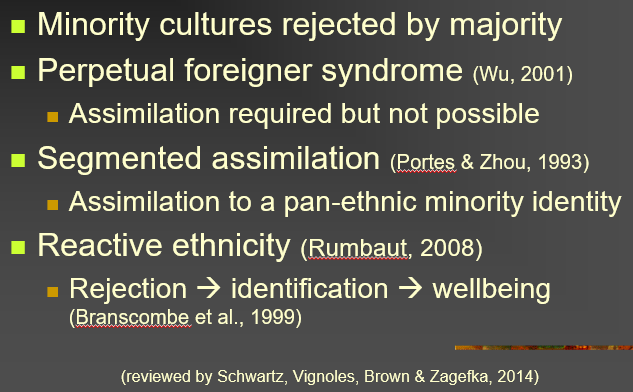when cultures meet - intercultural relations and global change
1/18
There's no tags or description
Looks like no tags are added yet.
Name | Mastery | Learn | Test | Matching | Spaced |
|---|
No study sessions yet.
19 Terms
what is modernisation?
economic development/industrialisation
changes in eco-cultural framework; expect cultures to adapt to new context
predicted that cultural beliefs and values will become more secular and more rational (Inglehart & Baker, 2000)
what is post-modernisation?
shift from manufacturing to service economy
predicted that cultural beliefs and values will become post-materialistic (Inglehart & Baker, 2000)
less focus on survival
greater focus on self expression
testing cultural change (world values survey)
7 waves from 1981 - present
representative national samples in >75 countries
traditional → secular-rational values
survival → self-expression values
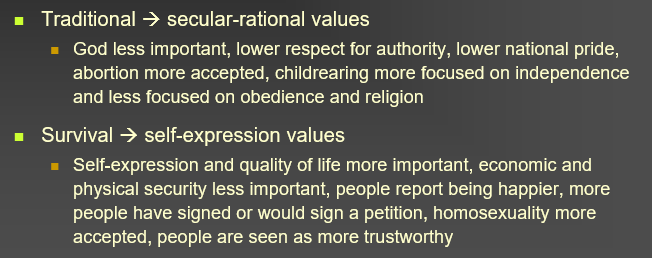
sources of intercultural contact
plural societies - migrants, sojourners, refugees, tourists, indigenous people
either voluntary or forced, sedentary or mobile, and permanent or temporary
what is acculturation?
“[it] comprehends those phenomena which result when groups of individuals having different cultures come into continuous first-hand contact with subsequent changes in the original culture patterns of either or both groups” Redfield, Linton, & Herskovits, 1936, cited in Berry, 1997, p. 7)
in practice, one group usually changes more (‘acculturating group’ vs ‘receiving society’ - minority vs majority)
effects of intercultural contact
adaptation processes (affective, behavioural, cognitive)
intergroup relations (power differentials, peaceful/hostile)
acculturation strategies (changes or not in practices, values, and identifications)
cultural changes (both groups, can lead to emergence of new cultures)
what are the ABCs of coping with ‘culture shock’ (Ward, Furnham, Bochner, 2001)?
affective
behavioural
cognitive
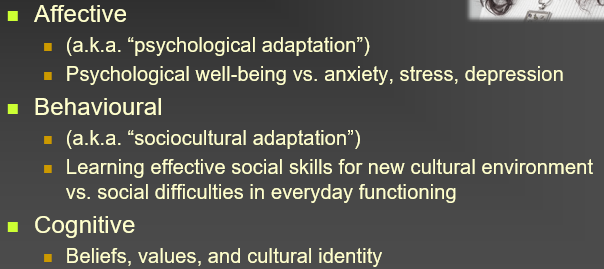
outdated view of acculturation
separation (cultural maintenance) vs assimilation (relationships with dominant group)

questions about acculturation according to Berry?
is it considered to be of value to maintain cultural identity and characteristics?
is it considered to be of value to maintain relationships with other groups?
what are the acculturation strategies (Berry, 1990, 1997)?
assimilation
integration
marginalisation
separation
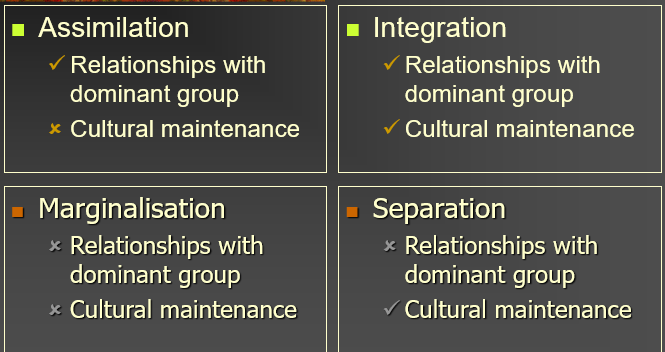
how are acculturation strategies measured?
Preferences for contact
Preferences for cultural maintenance
Cultural identities
Language use and proficiency
Cultural practices (food, clothing, media, etc.)
Family and peer relationships

results from acculturation surveys
Participants tended to prefer integration to the other acculturation strategies
Participants who adopted integration showed the best psychological adaptation / least stress
Marginalisation is least adaptive
Assimilation and separation show intermediate and more variable outcomes, depending on context
what is meant by ‘integration’?
living with multiple cultural identities
bicultural identity integration
perceptions - harmony or conflict?
strategies - blending or compartmentalising?
integration predicts wellbeing (especially harmony)
differences between settler (e.g. Australia, Canada, USA) vs non settler (France, Germany, UK) societies
integration more common in settler societies
separation predicts psychological adaptation better in non-settler societies
also varies with culture of origin
strategies of the dominant group
multiculturalism
melting pot
segregation
exclusion
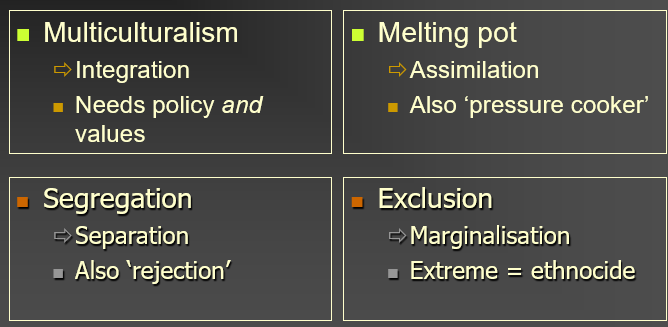
what is self categorisation theory (Turner et al, 1987)?
intercultural context → cultural identities
culture used to define self
what is social identity theory (Tajfel & Turner, 1979)?
striving for positive cultural distinctiveness
also maintain cultural continuity against threat
threats to majority and minority identities
majority group identity processes
may feel threatened
symbolic threats to national identity
realistic threats to social dominance
reject minority members or identity expressions
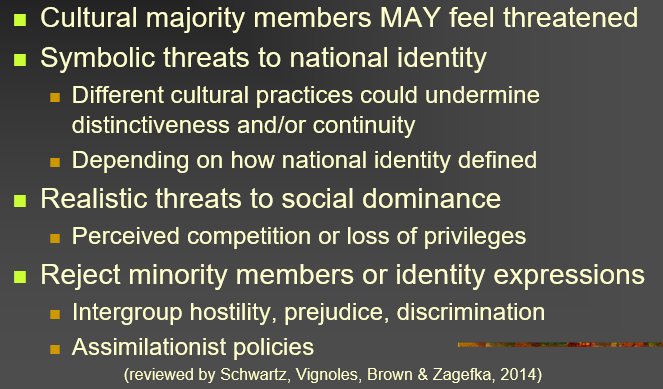
minority group identity processes
rejected by majority
perpetual foreigner syndrome (Wu, 2001)
segmented assimilation
reactive ethnicity
